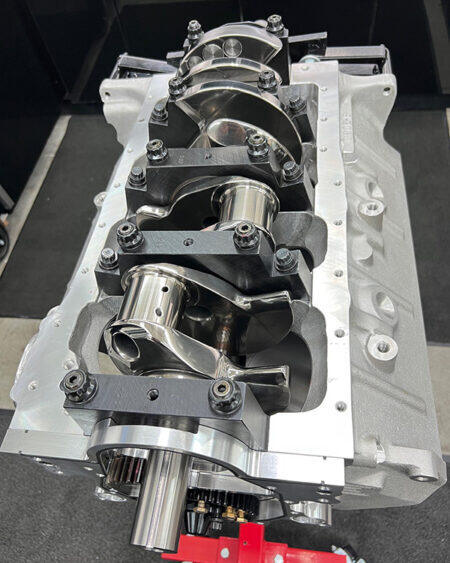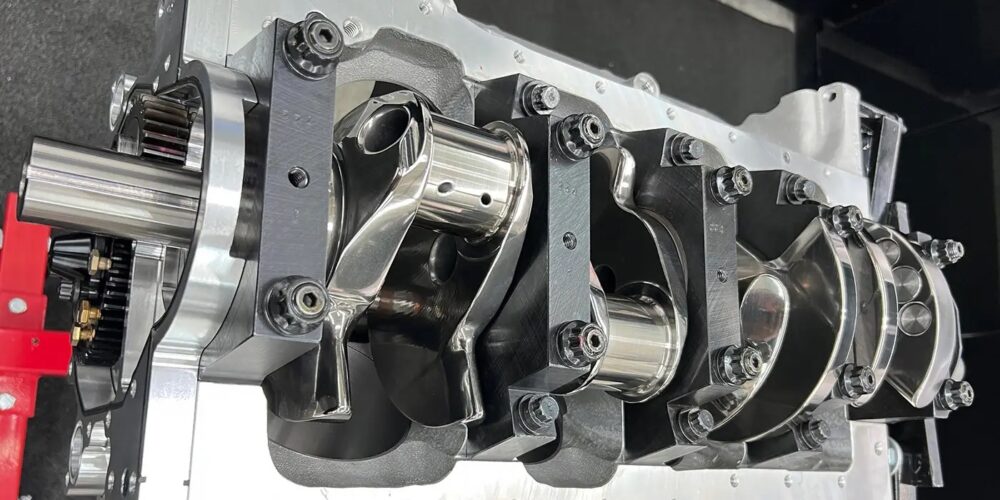We’ve all likely experienced the sudden THUMP, THUMP, THUMP of an unbalanced washing machine. It feels like the house is coming off the foundation at times! Well, consider that most washing machines top out between 800 and 1,400 rpm. Think about that similar effect on an engine at 6,500 or even higher rpm. That thumping sensation is how the engine bearings feel.
Okay, I admit, maybe that’s a little excessive, but then again, maybe not. Balancing, at its core, comes down to physics. Centrifugal force is the outward force on a rotating mass. It’s based on inertia, which is the tendency of an object to stay in motion until it is acted upon by another force. Physics defines centrifugal force as only an apparent, not a real force. Inertia is the actual force, and in the case of a crankshaft, the inertia of the pistons and rods want to keep them going in a consistent direction, until the crankshaft says, “Nope, time to go the other way.”

As these inertial forces act upon all moving components in an engine, if there’s an imbalance, it’s evidenced by vibration and ultimately damaging effects. Engine balance, therefore, becomes a critical consideration on any engine build.
There are two ways, related to the action of the components, to generate imbalance in an engine, reciprocating and rotating. Reciprocating imbalance refers to forces generated by the bobweight (all components that spin around the crank or go up and down) and can also be caused by the offset of the crank pins based on engine design. Rotating imbalance refers to forces generated by unbalanced rotating components (anything that moves in a circular motion around a central axis) such as the crankshaft or flywheel.
Then, within the field of reciprocating imbalance, we’re forced to visit the topic of physics once again, which tells us that inertia forces will yield two categories of imbalance – primary and secondary.

Primary imbalance occurs once per crankshaft revolution, and it’s easiest to think of when focusing on one single cylinder. During one crankshaft revolution, the piston goes from the top of the cylinder to the bottom, then back to the top. The reversal of inertia will cause a vibration, unless something offsets it. The crankshaft counterweights are designed to handle this.
Secondary imbalance occurs twice per crankshaft revolution. It is caused because piston speed varies throughout the rotation of the crankshaft. Near TDC and BDC, piston speed is much slower than the remainder of the upward and downward strokes.
Primary imbalance is a factor that is directly related to engine design, and in addition to the counterweights, crank pin locations and firing order contribute heavily to improving or worsening the problem. Regardless of the scientific complexities of it, dynamic balancing of the rotating assembly is performed to correct all reciprocating and rotating imbalance.
Balancing starts and ends with the crankshaft. We know the crankshaft counterweights offset or balance the inertia of the piston and connecting rod. They are cast or forged as part of the crank when it is made and balanced by adding or removing metal.

The advantages of a CCW crank are strength, less bending movement and reduced harmonics.

A typical “stock” crankshaft is balanced by drilling the counterweights to remove weight. Engineers know the weight of the pistons and rods and design the crank counterweights accordingly, making drilling to balance them the quickest method for production. Even though they are balanced at the factory, they are only balanced to an acceptable degree for “production line” vehicles, which are only designed for a certain type of use and performance to a certain level. In other words, they have loose tolerances in the interest of saving time and money. Racing or high performance requires balancing to a much higher degree.
A typical V8 crankshaft is sometimes referred to as a six-counterweight crankshaft, because that’s what most of them have. There aren’t counterweights off the webs on the center of the crank, and while cost ultimately drives almost everything from the standpoint of “stock” engine production, there are other reasons for it.
When counterweights are placed toward the ends of a crank, they have a greater effect on balancing, so they’re able to achieve engine balance with less weight. Due to this factor, the weights aren’t necessary in the middle, ultimately saving money in material and making the crank lighter in weight, offering quicker throttle response and rpm changes on top of the weight savings.
“The primary advantage of a stock, non-center counterweighted (CCW) crank is that it is lighter and will be a drop-in on almost any block,” says Jeremy Gillum, VP of engineering at SCAT Enterprises. “Clearance should always be checked, however, and windage is also reduced on a non-CCW crank, but the disadvantages of a non-CCW crank is that it will typically be a little weaker, more susceptible to center main wear, and require slightly more heavy metal based on the bobweight.”
Speaking of weight, why is balancing so important? Aside from the simple annoyance of a vibration, all that vibration is transferred into the bearings. That’s the bottom line. Engines live and die through their bearings and the crankshaft. Imbalance puts stress on the bearings, which will lead to bearing fretting and fatigue, i.e., bearing failure. Balance is so important, that while it’s often associated only with high-performance, a properly balanced engine in a daily driver will run smoother and quieter and last longer – period.
When you think about imbalance that’s easy to “see,” as in the case of the washing machine, you realize that something out of balance simply can’t spin up to a high rpm because the changing loads of the imbalance prevent it from happening. The forces are constantly fighting themselves back and forth. A crankshaft does the same thing in the bearings, not only causing bearing wear, but causing the rotating assembly to expend energy into the bearings as opposed to converting it to rotational energy.
Most engines are internally balanced, meaning all weight adjustment is done on the crankshaft counterweights. However, some stock and modified engines require external balancing due to an increased stroke or larger pistons, and the crankshaft counterweights that would be required to offset the increased inertia simply don’t fit inside the crankcase.

The solution is to place additional weight on the flywheel or flexplate and the harmonic balancer. An advantage to this is generally less weight required to attain the proper balance because the weights are positioned at the extreme ends of the crankshaft. A disadvantage is they cause additional twisting force to be transferred into the crankshaft, also due to the location of the weight.
When you’re shopping for a performance crankshaft, you’re going to see a lot of options for a CCW crank, sometimes referred to as an eight-counterweight crank. “The advantages of a CCW crank are that it will be a stronger crank that has less bending movement and reduced harmonics,” Gillum says. “It may also, in some cases, require less heavy metal to balance.”
Center counterweights don’t provide for a more precisely balanced crank, but they make it stiffer in the center, which now circles us back to bearings. The higher the rpm, the more a crank will tend to flex, the brunt of which is sent directly into the bearings. A stiffer crank handles higher rpm with less flex. Since rpm is part of the horsepower formula, the higher you go, the more you’re going to benefit from a CCW crank.
Since most stock cranks are six-counterweight cranks, you often have to clearance the block when installing a CCW or eight-counterweight crank. “We always try to design CCW cranks so clearancing isn’t necessary, but that being said, all crankshaft clearances should be checked,” Gillum points out.
Another component to consider is a harmonic damper. Often called a harmonic balancer, the job of the damper isn’t to balance the crank from reciprocating or rotational imbalance. While it does affect rotational balance and ideally should be balanced with the entire rotating assembly, its job is to dampen torsional vibration. Torsional vibration occurs when the torque impulses applied to a crankshaft occur at a frequency that matches its resonant frequency. This is caused by the torsional twist and rebound of the crank, resulting from the power impulses of combustion.
Torsional vibration cannot be balanced, but it must be dampened, or it will lead to oil pump gear failure, bearing damage, or crankshaft fatigue and failure. Harmonic balancers are an interference fit in order for the harmonics and torsional vibrations to be transferred into the balancer. There are different types of dampers based upon their construction, but in all cases, there is an additional element such as rubber or fluid that acts to dissipate energy and absorb harmonics.
At the end of the day, what’s the best crank to use? As always, it depends on weighing the pros and cons as they relate to your application, and the wallet of who’s paying the bill.














